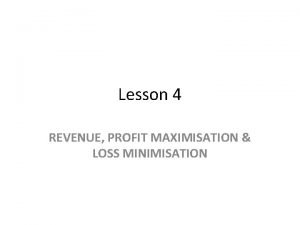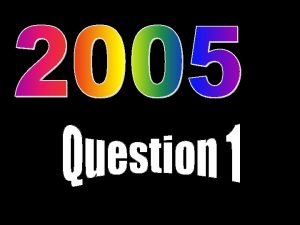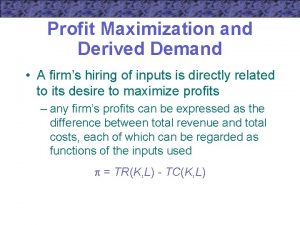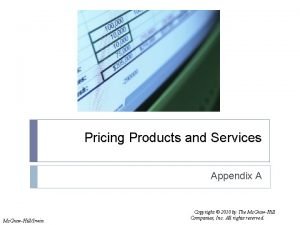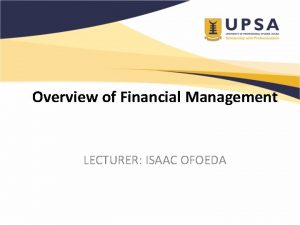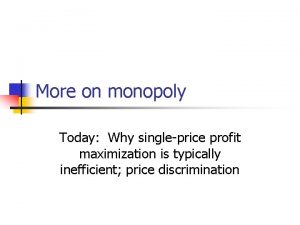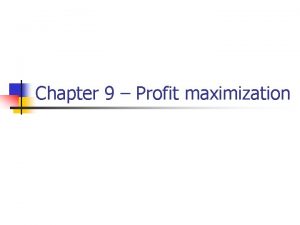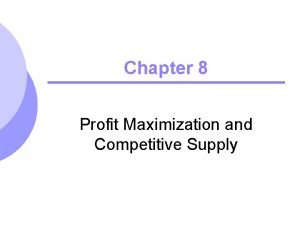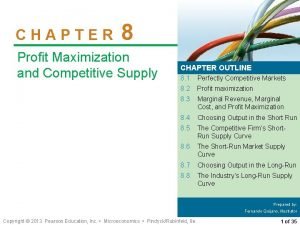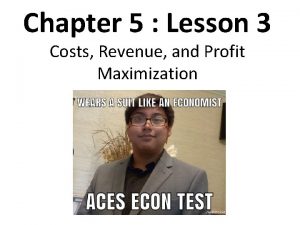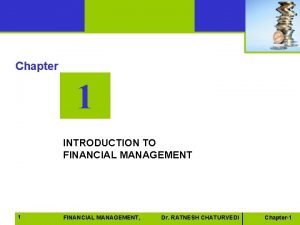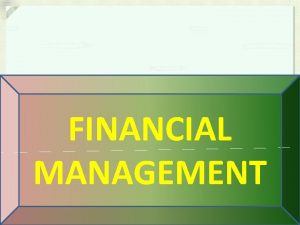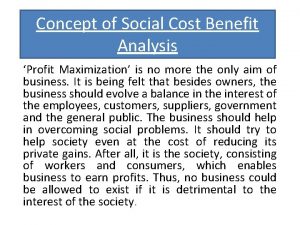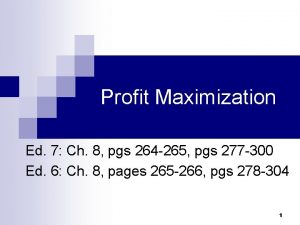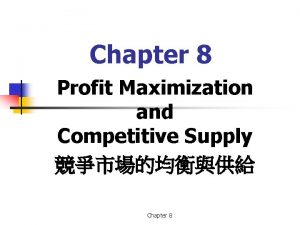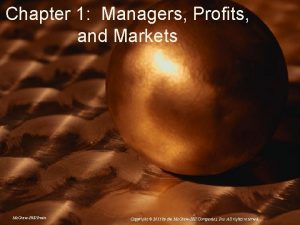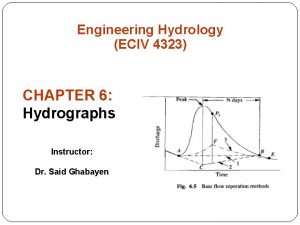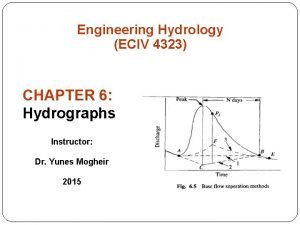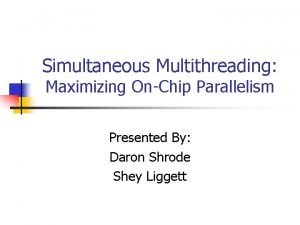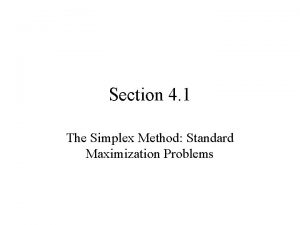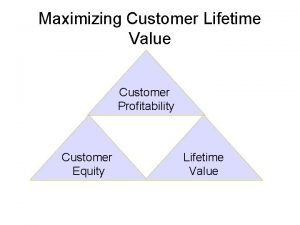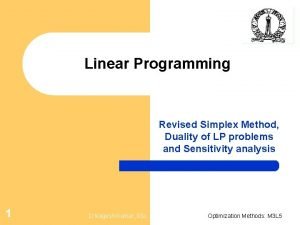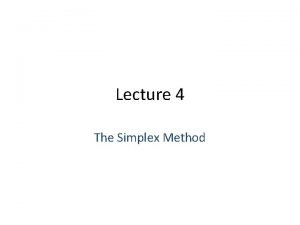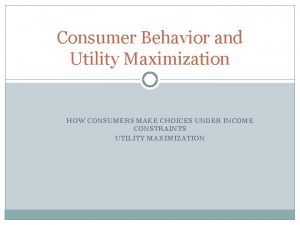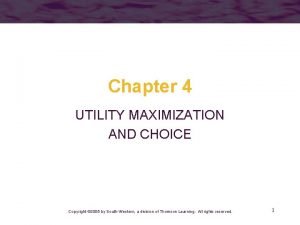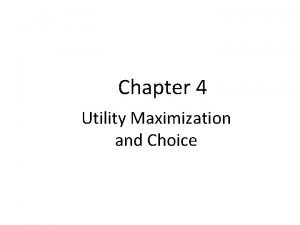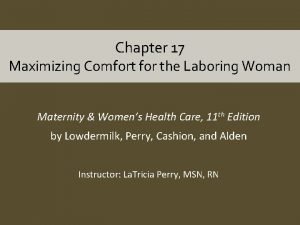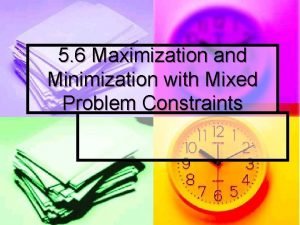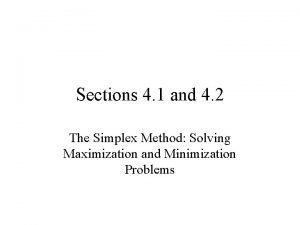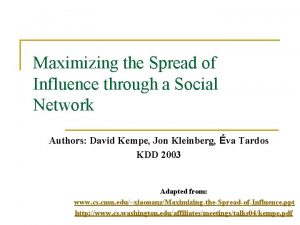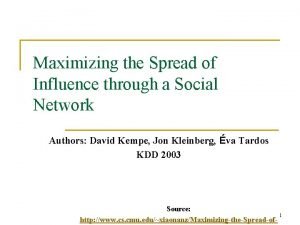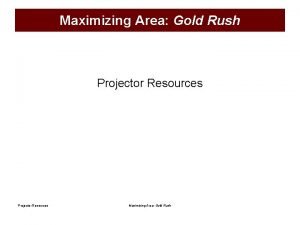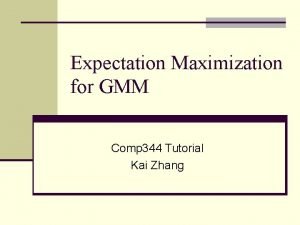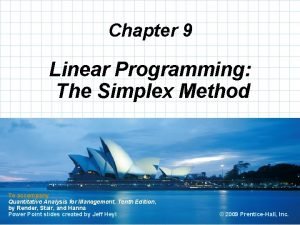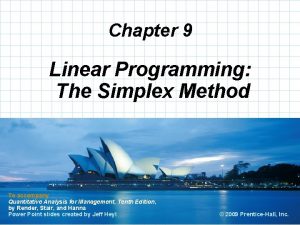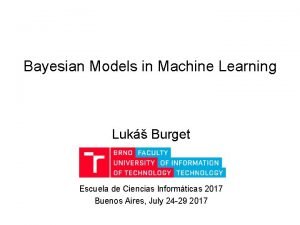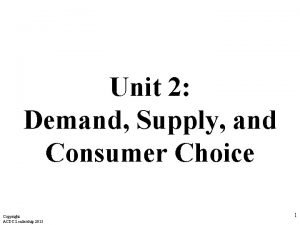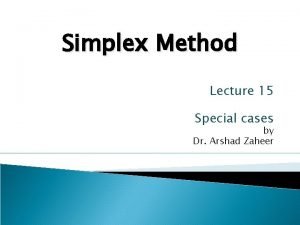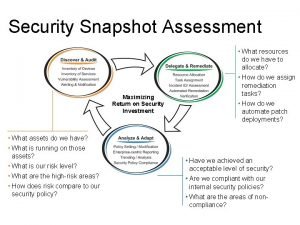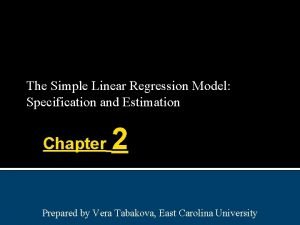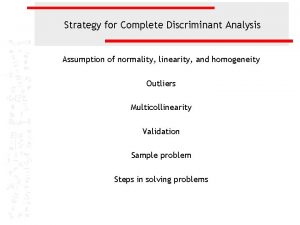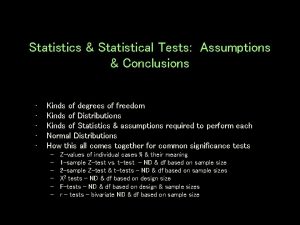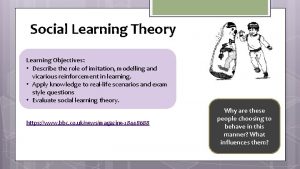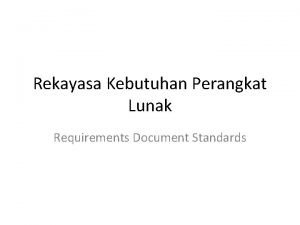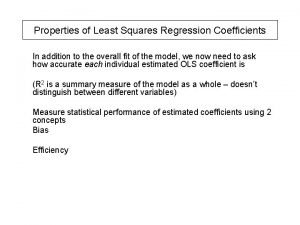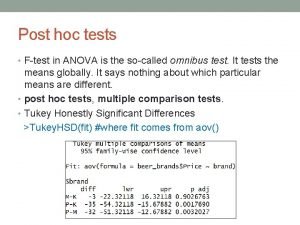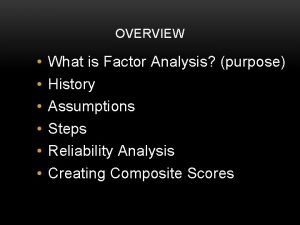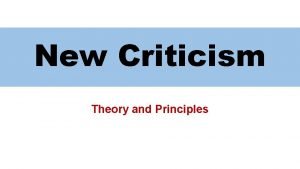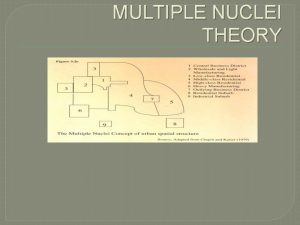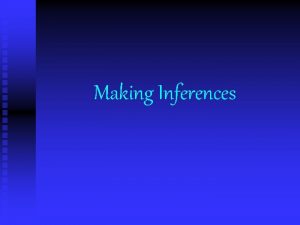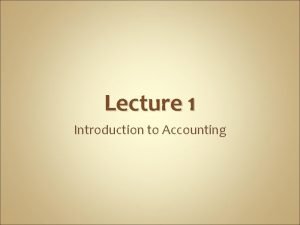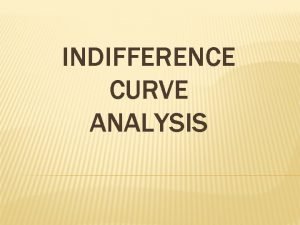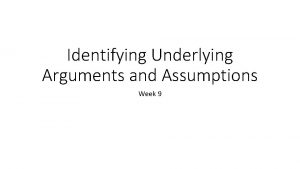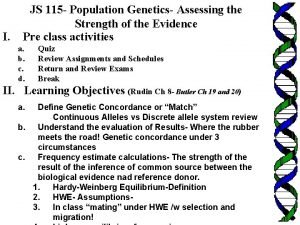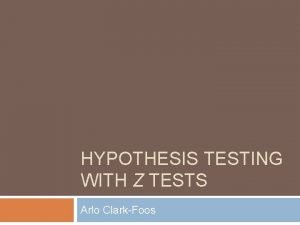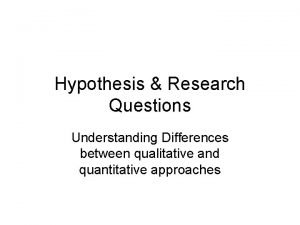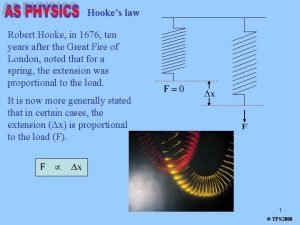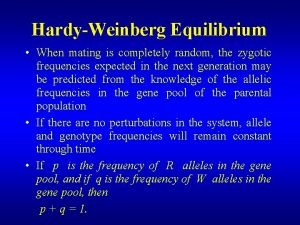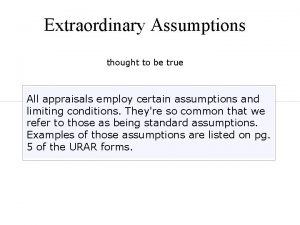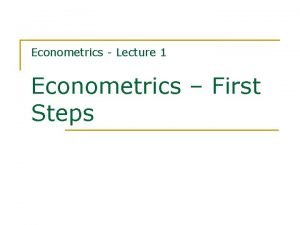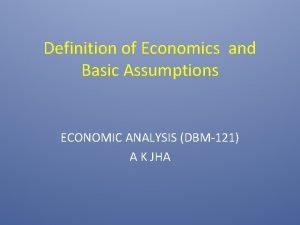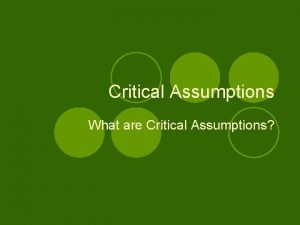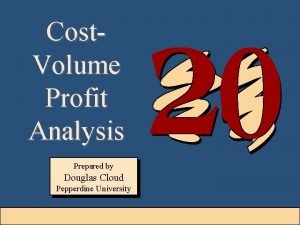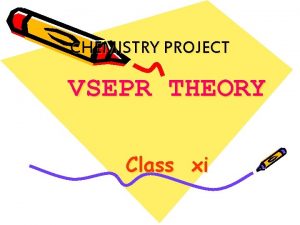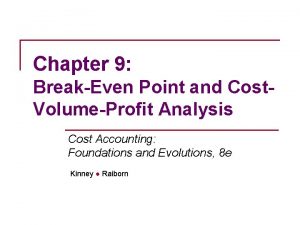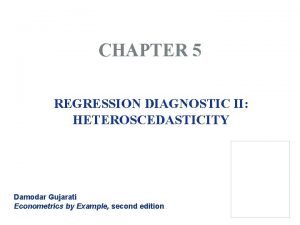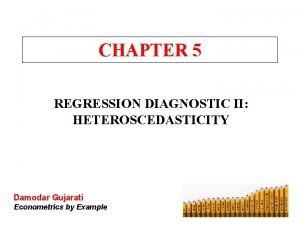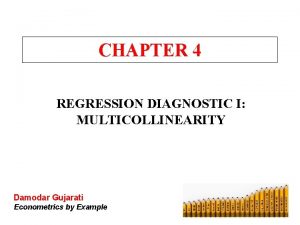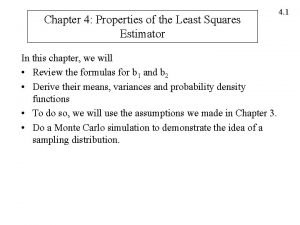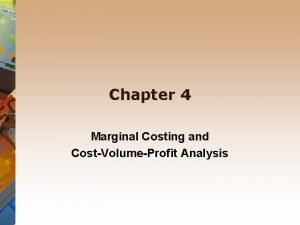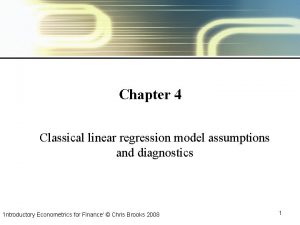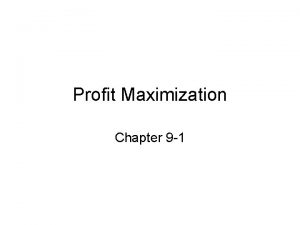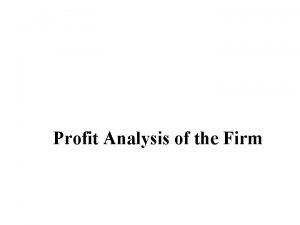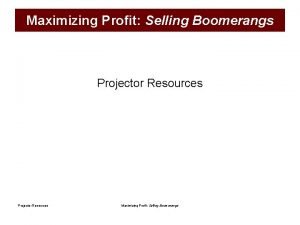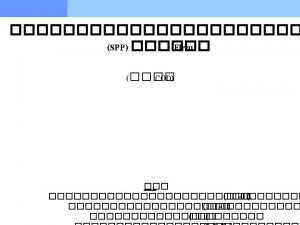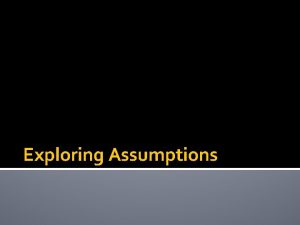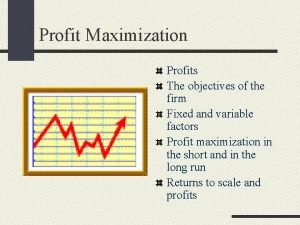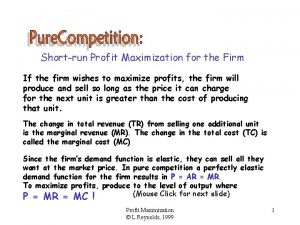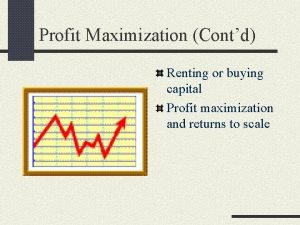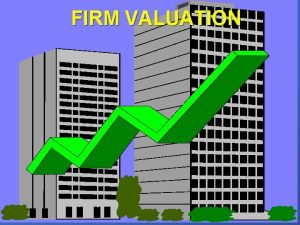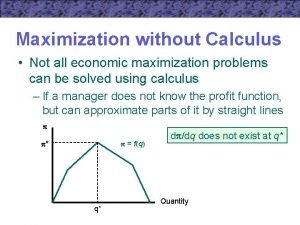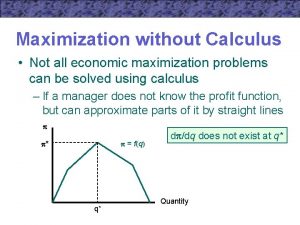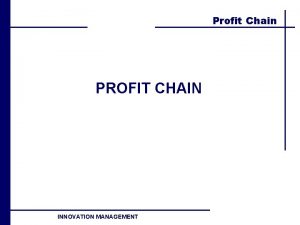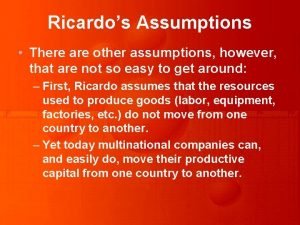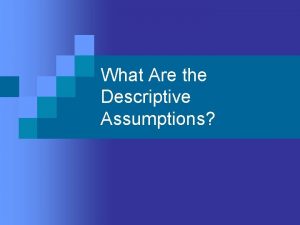Profit Maximization Profit Maximizing Assumptions Firm Technical unit

































































































- Slides: 97

Profit Maximization

Profit Maximizing Assumptions • Firm: Technical unit that produces goods or services. • Entrepreneur (owner and manager) – Gains the firm’s profits and suffers losses and has the goal of maximizing profit. – Transforms inputs (aka factors) into outputs through the technology of the production function. – Decides how much of each input to use and what quantity to produce.

Realistic? • For this class, we assume corporation’s with shareholders and boards and executives function like the entrepreneur. – Obviously, managers and executives have other incentives besides maximizing profit. – But there is a more developed theory of the firm for corporations that we will not get into. • Profit maximization? – Libraries and water utilities are strictly non-profit. – Most hospitals claim to be non-profit, but they act like for-profit hospitals.

Why Firms? • You could ask why even have firms? • Why don’t entrepreneurs outsource EVERYTHING? • Transactions costs make that infeasible. Or not. – In the 1870 s-1950 s vertical integration was the norm (River Rouge plant included a steel mill and processed rubber). – Since then, outsourcing has been growing. – New communication technology has driven this more towards the entrepreneur-only model.

Profit • Profit maximization could easily be 1/2 of the text as we assume firms maximize profit under a host of situations: perfectly competitive, monopoly, price discrimination, oligopoly, monopsony, etc. • However, the basics are perfect competition (price taker) and monopoly (price setter).

Price Taker vs Price Setter • Profit is TR-TC • Price Taker (competitive firm) – Treat the price they face as given when choosing quantity • Price Setter (single price, no strategic behavior) – Price is chosen along with quantity. • Short and long run options are the same – Short Run, quantity decision includes the shut down option – Long Run, consideration of returns to scale and entry and exit

Profit • Profit = TR-TC – Total costs include all implicit and explicit costs (unlike accounting cost that would only include explicit costs). • In our model, we assume the firm rents capital at a rate of v. But that is exactly the same as if the firm owned the capital but could rent it out to another firm at a rate of v. • Accounting profit using the firm’s owned resources in the next best alternative use – Includes Value of the entrepreneur’s time – Selling off owned factors and investing elsewhere – For us, SC = VC + FC = w. L + v. K

Price Takers • The rest of this lecture focuses on price takers. – Homogeneous output – No barriers to entry/exit in long run – Many sellers – Perfect price information

Revenue: Price Taker • Price Taker P Market Demand However, price taker assumption is that no firm is big enough to be able to affect the market price. p = Pm 1, 000 2, 000 3, 000 q • If a firm charges p > Pm , they will sell q = 0 • Demand for firm’s output is p = Pm, the firm can sell as many as it wants, until q = 3, 000, and then need to lower the price to sell more.

Revenue: Price Taker • So for price taker, we assume decreasing returns to scale precludes getting large enough to have production influence price: P Demand for firm: Pm = MR = AR p = Pm 1, 000 3, 000 5, 000 • So R = p·q, where p = Pm q

Cost and Short Run Supply • Let’s for the moment assume production exhibits IRS and then DRS. • Firms will, in the LR, choose a level of K commensurate with getting the lowest possible SAC. • The price will be driven to the low point of AC, the break even price. • At this starting point, the firm’s SAC, AVC, and SMC are relevant in the short run • Other returns to scale options considered in the long run. C SRC Exhibits IMR, DMR C AC SMC Exhibits IMR, DMR MC SMC AC SAC Ehhibits IRS, DRS q pbe AVC q

Cost and Short Run Supply • But for the moment, we don’t care which level of K the firm has or what the AC curve looks like. • In the SR, here is what we have to work with. • To determine the profit maximizing level of q = q*, and whether shut down and produce q = 0, MC and SAVC are most important. C SC SC Exhibits IMR, DMR AC SRMC Exhibits IMR, DMR SAC AVC SMC q q

Profit Max • Maximize π = R(q) - C(q) • FOC for this yields q where slope of π function = 0 SC SC R=p·q π=R-SC MR=P slope of R π maximized at q where MR=SMC FOC, derivative of π function is zero SMC = slope of SC q q

Profit Max • Checking the SOC too. SC SC R π=R-SC MR=P slope of R π also minimized at q where MR=SMC (FOC satisfied here too) Which is why we check SOC, to make sure profit is falling where MR = SMC (i. e. MR is falling relative to SMC) SMC = slope of SC q q

Profit Max • • The more common graph Maximize π = R(q) - C(q) FOC for this yields MR=SMC, which it does twice. SOC ensures MC is rising relative to MR R C SC SC AC SMC Exhibits IMR, DMR SMC q q

Price Taker Profit Max • So long as you are better off producing than not, • As you increase q, the change in profit = MRSMC. • Produce until MR = SMC and marginal profit (change in profit as q increases) is falling.

To Maximize Profit Q MR 99 TR 12 SMC 1188 SC Change in Profit = (MR -MC) 1000 I pulled these starting values out of the air 188

To Maximize Profit Q MR TR SMC SC Change in Profit = (MR -MC) 99 12 1188 1000 12 1200 7 1007 +5 193 101 12 1212 8 1015 +4 197 102 12 1224 9. 10 1024. 10 +2. 90 199. 90 103 12 1236 10. 40 1034. 50 +1. 60 201. 50 104 12 1248 12 1046. 50 0 201. 50 105 12 1260 13. 80 1060. 30 -1. 80 199. 70 106 12 1272 16 1076. 30 -3 195. 70 Note, at π max, AR > ATC. When AR = ATC, π = 0 188

Graphically

MC and qs: If price was $16, then the firm would produce 106.

MC and qs: If price was $10. 40, then the firm would produce 103.

MC and qs: If price was $8. 00, then the firm would produce 101.

MC and Supply • Price Takers – The MC curve tells us the profit maximizing qs by the firm at any price. – Since it is the MC curve that determines the relationship between p and the quantity to supply, the SMC curve IS the firm’s short run supply curve. – Important caveat, if suffering a loss, firm might want to shut down if the loss is larger than FC. • Side note: Price Setters – set the price, they do not respond to it, so they have no supply curve.

Shut Down Option (price takers and price setters) • Shut down: Short run situation where the firm produces a quantity of 0 while remaining in the industry. It is still considered to be in the industry as long as it cannot rid itself from its fixed inputs. • The firm could start producing very easily by employing some of the variable input.

Intuition • A firm bearing a loss can produce qs = q*, (where MR=MC) or can shut down, produce qs = 0. – If qs = q*: π = R – VC – FC – If the firm shuts down: π = -FC (that is, has a loss = FC) • If FC is greater than the loss from producing, qs = q*. If FC is less than the loss from producing qs = q*, better to shut down and produce qs=0. • Decision Rule: Shut down if R = 10, 000 R = 7, 000 – FC > R – VC – FC Profit from shut down Profit from q=q* VC = 8, 000 FC = 4, 000 π = -2, 000 -4, 000 < -2, 000 qs = q * VC = 8, 000 FC = 4, 000 π = -5, 000 -4, 000 > -5, 000 qs =0

Decision Rule • Shut down if: –FC > R – VC – FC 0 > R – VC R > VC • So long as revenue covers all variable cost, the loss will be less than FC so q = q*.

Side note: Which can change the firm’s output decision, a change in Variable Cost and/or a change in Fixed Cost? • Shut down if: – FC > • – FC > R – VC – FC • FC is on both sides, so a change in FC does not affect the relationship or the decision. • Ok, yes, fixed costs are fixed (don’t vary with output) • health insurance premiums rise • Tony Romo signs a $108 m extension. • But a change in either R or VC could change the decision.

Price Taker in the Short Run • Simple, just MR = MC • Maximize profit w. r. t. q • Maximize profit w. r. t. L

Profit Max 1 • Simple, supply is SMC, find q where SMC = p.

Profit Max 2, MR = MC • Optimize by choosing q.

Profit Max 3, MRPL=w • Optimize by choosing L.

Producer Surplus • Producer surplus is the amount by which a firm is better off than shut down (q=0) • If shut down, loss is = FC • By producing, the firm covers this potential loss, plus gains profit. • If profit = 0, then better off by the amount of FC • PS = π + FC • PS = R-VC-FC+FC • PS = R-VC

Producer Surplus • If π = 0, then producer surplus = FC • If π < 0, but -π < FC, producer surplus > 0 • If π < 0, and -π = FC, producer surplus = 0 • Shut down point • If π < 0, and -π > FC, producer surplus < 0 • Will shut down, so PS = 0 and profit = -FC.

Profit Maximization Price Taker, Long Run • Returns to Scale Matter – IRS, LMC falling – CRS, LMC constant – DRS, LMC rising

Increasing Returns to Scale • IRS only: incompatible with competition as the biggest firm has the lowest average cost… natural monopoly results C AC MC q q

Decreasing Returns to Scale • DRS only: an infinite number of infinitely small firms. C AC MC AC q q

Constant Returns to Scale • CRS only: any size firm can produce at the same AC. AC = AVC = MC (Firm LRS is horizontal at MC). C AC MC C AC=MC q q

IRS, DRS • IRS, DRS: MC rising. Firm LRS = MC above AC (exit otherwise. C C AC MC MC AC Exhibits IRS, DRS q q

IRS, CRS, DRS • IRS, CRS, DRS: MC rising, but flat spot while CRS. • Perhaps most realistic, but not easy to solve – or find a production function that creates this. C C AC MC DRS Firm LRS = MC for p ≥ p. BE MC CRS AC IRS q q

Profit Max. vs. Perfect Comp. • We will eventually assume that in the long run K will be fixed to yield this SAC and the market price will be pbe (so in the LR q* will be at the low point of SAC) • But in this chapter, we want to explore the possibility that price will exceed pbe for a while. So we need a firm LRS curve. AC MC SAC SMC MC SAC AC Firm exit if p < p. BE q

Production and Exit • Essentially, a firm’s long run supply curve will be its long run MC curve… • While shut down is a viable option in the short run, in the long run all costs can be avoided by exiting the market. • If p < pbe, (minimum value of AC curve), the firm should exit the industry. • So firm long run supply is MC above pbe.

Price Taker in the Long Run • Simple, just MR = MC • Maximize profit w. r. t. q • Maximize profit w. r. t. K, L

Profit Max 1 • Simple, set MC = P, find q.

Profit Max , MR=MC • Optimize by choosing q

Profit Max, MRPL=w; MRPK=v • Optimize by choosing inputs

Profit Max, choose K and L • Ratio of FOC

Profit Max, choose K and L • SOC

Profit Max, choose K and L • Profit function, maximal profits for a given w, v, and p.

Properties of the Profit Function • Homogeneous of degree one in all prices – with inflation, K*, L*, and q* are the same profit will keep up with that inflation • Nondecreasing in output price – Δ profit ≥ 0 with Δ p > 0 • Nonincreasing in input prices – Δ profit ≤ 0 with Δ w or Δ v > 0 • Convex in output prices – profits from averaging those from two different output prices will be at least as large as those obtainable from the average of the two prices

Envelope Results • Long run supply To maximize profit when there is a change in price , q=q*= f(K*, L*), continue producing such that L* = L(w, v, p) K* = K(w, v, p)

Envelope Results • Profit maximizing factor demand functions To maximize profit when there is a change in w, choose L such that L = L*=L(w, v, p)

Comparative Statics • Price taker • Long run

Comparative Statics (∂L/∂w, ∂K/∂w) • K* and L * back into the FOC to create the following identities

Comparative Statics (∂L/∂w, ∂K/∂w)

Comparative Statics (∂L/∂w, ∂K/∂w) • Increase in wage, increases MC, q* falls K L falls, K rises L

Comparative Statics (∂L/∂w, ∂K/∂w) • Increase in wage, increases MC, q* falls K L falls, K falls L

Comparative Statics (∂L/∂v, ∂K/∂v)

Comparative Statics (∂L/∂p, ∂K/∂p) • K* and L * back into the FOC to create the following identities

Comparative Statics (∂L/∂p , ∂K/∂p) So long as f. KL is positive or small, these will both be > 0. Since an increase in P causes MR to rise, at least one of these must be > 0

Comparative Statics (∂L/∂p, ∂K/∂p) • Increase in p, increases MR, q* rises K L rises, K rises L

Comparative Statics (∂L/∂p, ∂K/∂p) • Increase in p, increases MR, q* rises K L rises, K falls K inferior Obviously, L could be inferior instead Expansion path L

Comparative Statics (∂q/∂p) • q = f(L, K) • q*=f(L*=L(w, v, p), K*=K(w, v, p)) • How does this respond to a change in p?

Comparative Statics (∂q/∂p) • And so we can substitute to get:

The Short Run and the Long Run Le Châteliar Principle • How does the short run demand for L differ from the long run demand? K Increase in the wage rate K 2 K 0 q*(w 1) q*(w 2) LL * Ls * L* L

Short Run Profit Max

Long Run vs. Short Run And we can deduce > 0, by SOC

Short Run Profit Max • Input demand in the long run is more elastic. “These types of relations are …referred to as Le Châtelier effects, after the similar tendency of thermodynamic systems to exhibit the same types of responses. ” – Silberberg, 3 rd ed. (p. 85)

Cobb-Douglas Examples • Three cases: • • •

• Cost Min

• Cost Min


• MC, AC q

• Profit Max

• Profit Max


• Envelope Results

• Profit Max MC, AC MR q* q

• Cost Min

• Cost Min


• MC, AC q

• Profit Max

• Profit Max

• L *, K * • Π* • Envelope Results? No.

• MC, AC At MR 1 > MC, π-max at q = ∞ At MR 2 < MC, π-max at q = 0 At MR = MC, π-max at any q (π=0) MR 1 MR 2 q

• Cost Min

• Cost Min


• MC, AC q

• Profit Max Cost minimizing tangency

• Profit Max • SOC indicate we have a profit min, not a max.


• MC, AC Maximizing profit means q=∞, where MR ≠ MC MR Only produce units where MR < MC! q* q

Appendix Short Run vs. Long Run Labor demand • Demand for labor can be written: • Differentiate w. r. t. w: • But let’s try to sign The slopes of the SR and LR factor demand functions differ by a term that is the product of two effects: change in K from a change in w and the change in L that WOULD be caused by a change in the fixed amount of K. – Differentiate original equation w. r. t. v

Now what? • From the differential w. r. t. v: sign-wise, all we know is this is < 0 Which tells us these two must have opposite signs. • Rearrange for this: Because of the opposite signs, this is < 0 • And substitute into:

Now what? • Yields: • And from reciprocity • Yielding:

Finally • And we can say: >0 <0 • Since all terms are < 0, it is clear that the short run effect is smaller than the long run effect.
 Revenue maximisation point
Revenue maximisation point Lratc
Lratc Social cost of monopoly
Social cost of monopoly Monopsony profit maximization
Monopsony profit maximization Profit-maximizing price formula
Profit-maximizing price formula Limitations of profit maximization
Limitations of profit maximization Monopoly profit maximizing price
Monopoly profit maximizing price Single price monopoly graph
Single price monopoly graph Profit maximization
Profit maximization Profit maximization and competitive supply
Profit maximization and competitive supply Profit maximization and competitive supply
Profit maximization and competitive supply Cost revenue and profit maximization guided reading
Cost revenue and profit maximization guided reading Module 53 featured worksheet profit maximization
Module 53 featured worksheet profit maximization Dr sudhindra bhat
Dr sudhindra bhat Meaning of financial management
Meaning of financial management Abt model of social accounting
Abt model of social accounting Profit maximization
Profit maximization Profit maximization and competitive supply
Profit maximization and competitive supply Economic profit vs accounting profit
Economic profit vs accounting profit Post acquisition profit is which profit
Post acquisition profit is which profit The basic assumptions of the unit hydrograph theory are
The basic assumptions of the unit hydrograph theory are The basic assumptions of the unit-hydrograph theory are
The basic assumptions of the unit-hydrograph theory are Simultaneous multithreading: maximizing on-chip parallelism
Simultaneous multithreading: maximizing on-chip parallelism Standard maximization problem
Standard maximization problem Maximizing instructional time in the classroom
Maximizing instructional time in the classroom Customer lifetime value maximization
Customer lifetime value maximization Simplex method
Simplex method Simplex
Simplex Utility maximizing combination
Utility maximizing combination Utility maximization problem
Utility maximization problem Perfect substitutes
Perfect substitutes Chapter 17 maximizing comfort for the laboring woman
Chapter 17 maximizing comfort for the laboring woman Big m method minimization with mixed constraints
Big m method minimization with mixed constraints Simplex method maximization calculator
Simplex method maximization calculator Maximizing the spread of influence through a social network
Maximizing the spread of influence through a social network Maximizing the spread of influence through a social network
Maximizing the spread of influence through a social network Maximizing area
Maximizing area Expectation maximization tutorial
Expectation maximization tutorial Onboarding new employees maximizing success
Onboarding new employees maximizing success The zj row in a simplex table for maximization represents
The zj row in a simplex table for maximization represents The zj row in a simplex table for maximization represents
The zj row in a simplex table for maximization represents Expectation maximization algorithm
Expectation maximization algorithm Utility maximization
Utility maximization Unbounded solution in simplex method
Unbounded solution in simplex method Motor power constant
Motor power constant Maximizing security roi
Maximizing security roi Unit 10, unit 10 review tests, unit 10 general test
Unit 10, unit 10 review tests, unit 10 general test Unit 4 common specialist technical principles answers
Unit 4 common specialist technical principles answers Accounting assumptions
Accounting assumptions Von thunen model definition
Von thunen model definition Lesson plan assumptions
Lesson plan assumptions Gauss markov assumptions
Gauss markov assumptions Capm assumptions
Capm assumptions Mercantilist laws
Mercantilist laws Discriminant analysis assumptions
Discriminant analysis assumptions Assumptions in statistics
Assumptions in statistics Evaluate social learning theory
Evaluate social learning theory Ieee std 830
Ieee std 830 Gauss markov assumptions
Gauss markov assumptions Cov(ui uj)=0
Cov(ui uj)=0 Assumption of anova
Assumption of anova Factor analysis assumptions
Factor analysis assumptions Humanistic values of organizational development
Humanistic values of organizational development Assumptions and dependencies example
Assumptions and dependencies example Discuss the principles and methodology of new criticism
Discuss the principles and methodology of new criticism Multiple nuclei model criticisms
Multiple nuclei model criticisms Welch anova matlab
Welch anova matlab Accounting conventions and principles
Accounting conventions and principles The cvp income statement classifies costs
The cvp income statement classifies costs Assumptions vs inferences
Assumptions vs inferences Criticism of concentric zone theory
Criticism of concentric zone theory Accounting principles
Accounting principles The three most common inventory cost flow assumptions are
The three most common inventory cost flow assumptions are Assumptions generalizations predictions vs. conclusion
Assumptions generalizations predictions vs. conclusion Indifference curve analysis assumptions
Indifference curve analysis assumptions Value assumptions
Value assumptions 5 hardy weinberg assumptions
5 hardy weinberg assumptions Assumptions of hypothesis testing
Assumptions of hypothesis testing Qualitative hypothesis example
Qualitative hypothesis example Law of hooke
Law of hooke Historical analysis research
Historical analysis research Hardy weinberg assumptions
Hardy weinberg assumptions Extraordinary assumption definition
Extraordinary assumption definition Econometrics
Econometrics Definition of economics by adam smith
Definition of economics by adam smith Critical assumptions
Critical assumptions Cost volume profit
Cost volume profit Cognitive approach assumptions
Cognitive approach assumptions Vsepr project
Vsepr project Break-even point in units formula
Break-even point in units formula Durbin chap
Durbin chap How to detect heteroscedasticity
How to detect heteroscedasticity Heteroscedasticity
Heteroscedasticity Assumptions of clrm gujarati
Assumptions of clrm gujarati Deriving least squares estimators
Deriving least squares estimators Desired sales formula
Desired sales formula Assumptions of the classical linear regression model
Assumptions of the classical linear regression model Cvp analysis assumptions
Cvp analysis assumptions
